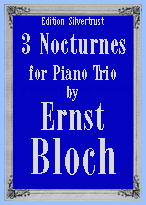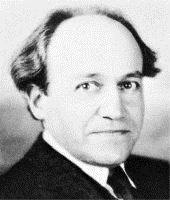Presents
Ernest Bloch
 |
 |
Soundbites |
Three Nocturnes for Piano Trio, Op.56
Ernest Bloch (1880-1959) was born in the Swiss city of Geneva. He received violin lessons as a child but started composing on his own. He eventually enrolled at the Brussels Conservatory where he studied violin with Eugène Ysaÿe and then later studied composition with Iwan Knorr at the Frankfurt Conservatory. In 1916, he moved to the United States where he remained for the rest of his life. He became a prominent teacher, serving as the first director of the Cleveland Institute of Music and later of the San Francisco Conservatory. Among his many students were George Antheil, Frederick Jacobi, Bernard Rogers, and Roger Sessions. Bloch's early works show the influence of of Richard Strauss but also of Claude Debussy. Once can hear elements of post-Brahmsian late German romanticism as well as French impressionistic effects works from this period. As time went on, he tended to use Jewish liturgical and folk music for his inspiration. He composed in virtually every genre.
Bloch's Three Nocturnes for Piano Trio were competed in 1925 while he was still at the Cleveland Institute of Music. He did not give the nocturnes titles, but the tempo markings give some idea of what the music is like. The first nocturne, Andante, shows has the aura Impressionism with its gossimer themes and exotic effects like the use of ponticello. The marking to the second nocturne, Andante quieto, pretty well describes the music. It is muted and calm with long-lined melodies. The final highly rhythmic nocturne, Tempestoso, is just that, dark and stormy.
This is a highly evocative and effective work suitable for concert as a whole. Additionally, each nocturne can easily be used as an encore. The work is well within the reach of amateurs who will also find it quite attractive.
Parts: $16.95
![]()